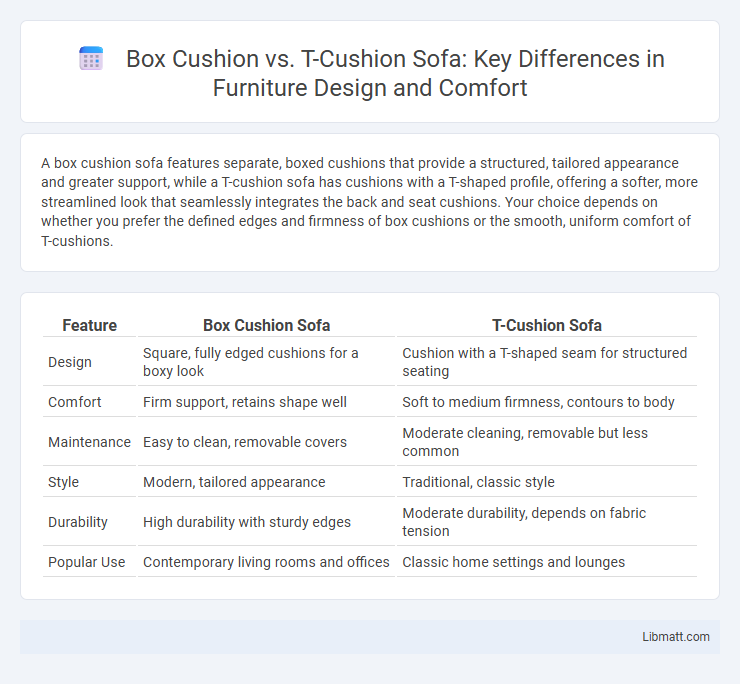A box cushion sofa features separate, boxed cushions that provide a structured, tailored appearance and greater support, while a T-cushion sofa has cushions with a T-shaped profile, offering a softer, more streamlined look that seamlessly integrates the back and seat cushions. Your choice depends on whether you prefer the defined edges and firmness of box cushions or the smooth, uniform comfort of T-cushions.
Table of Comparison
| Feature | Box Cushion Sofa | T-Cushion Sofa |
|---|---|---|
| Design | Square, fully edged cushions for a boxy look | Cushion with a T-shaped seam for structured seating |
| Comfort | Firm support, retains shape well | Soft to medium firmness, contours to body |
| Maintenance | Easy to clean, removable covers | Moderate cleaning, removable but less common |
| Style | Modern, tailored appearance | Traditional, classic style |
| Durability | High durability with sturdy edges | Moderate durability, depends on fabric tension |
| Popular Use | Contemporary living rooms and offices | Classic home settings and lounges |
Understanding Box Cushion and T-Cushion Sofas
Box cushion sofas feature cushions with distinct, well-defined edges created by fabric panels sewn together, offering a structured and tailored appearance ideal for modern and transitional interiors. T-cushion sofas have cushions with a single seam running across the center, forming a "T" shape that provides a softer, more relaxed look often favored in casual or vintage-inspired designs. Understanding these cushion styles helps in selecting a sofa that aligns with both aesthetic preferences and desired comfort levels.
Key Design Differences
Box cushions feature a straight, defined edge with a uniform thickness, creating a structured and tailored appearance, while T-cushions have an extended front section resembling the shape of the letter "T," providing extra support along the sofa's edge. The box cushion design emphasizes clean lines and simplicity, commonly used in modern and minimalist sofas, whereas T-cushions enhance comfort and durability by preventing cushion slumping in sectional corner seats. Material choices for box cushions often include high-density foam for firmness, contrasting with the layered filling in T-cushions that combines foam with fiber for resilience and softness.
Comfort Comparison
Box cushion sofas offer firmer support with well-defined edges, providing a structured seating experience ideal for maintaining posture. T-cushion sofas feature softer, more padded cushions with a relaxed, contoured shape, enhancing comfort for extended lounging. Your choice depends on whether you prefer firm support or a plush, cozy feel for daily relaxation.
Support and Durability
Box cushions offer firmer support with a structured shape that maintains its form over time, making them ideal for prolonged seating. T-cushions provide a softer, more padded feel but may compress faster, affecting long-term durability. Choosing between them depends on your preference for consistent support or a plush, comfortable experience.
Aesthetic Appeal and Style
Box cushions offer a clean, tailored look with defined edges that enhance modern and minimalist aesthetics, creating a structured and formal appeal. T-cushions feature softer, rounded edges that contribute to a relaxed, casual vibe ideal for cozy, traditional, or transitional interiors. The choice between box and T-cushions significantly impacts the sofa's visual style and how it complements the overall room decor.
Best Uses for Box Cushions
Box cushions are ideal for sofas requiring firm, defined edges and a tailored, structured look, providing excellent support for both sitting and lounging. They excel in high-traffic living rooms or formal settings where durability and maintaining shape over time are essential. Their thick, boxy design also offers sturdy back support, making them suitable for extended use and ergonomic comfort.
Best Uses for T-Cushions
T-cushions are ideal for sectional sofas as they provide seamless corner support and enhanced comfort, fitting perfectly into L-shaped configurations. Their design offers superior cushioning for frequent gatherings and lounging, making them perfect for living rooms where family and friends congregate. The T-shape allows for easier movement and cleaning compared to box cushions, adding functional convenience to their ergonomic benefits.
Cleaning and Maintenance
Box cushions offer a more structured shape with defined seams, making them easier to spot-clean and maintain without losing form. T-cushions, having a continuous, flatter surface, can trap more dirt in the seams, requiring more frequent vacuuming and occasional professional cleaning. Choose box cushions for straightforward upkeep and T-cushions if you prefer a sleek look but are prepared for slightly more detailed maintenance.
Cost Considerations
Box cushions typically have a higher cost due to their more structured design and additional materials required for the firm edges, making them a premium choice for sofas. T-cushions are generally more affordable as their simpler shape uses less fabric and filling, resulting in lower manufacturing expenses. Budget-conscious buyers often prefer T-cushions for cost savings without sacrificing comfort.
Which Cushion Style is Right for You?
Choosing between box cushion and T-cushion sofas depends on your comfort preferences and aesthetic goals. Box cushions feature defined edges and a structured look, providing firm support ideal for those who prefer a tailored appearance. T-cushions offer a softer, more seamless design with rounded edges, making them perfect if your priority is ultimate coziness and a casual vibe for your living space.
Box Cushion vs T-Cushion Sofa Infographic

 libmatt.com
libmatt.com